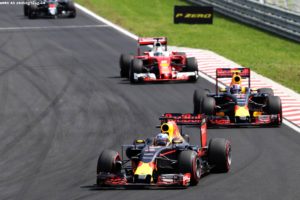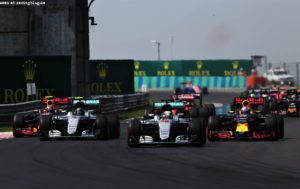Not the thriller that last year’s Hungarian Grand Prix proved to be, this year’s event was nevertheless tense in the battle between the Red Bull and Ferrari cars and strategy was pivotal to the outcome for a number of drivers.
 Ferrari has not had the best time of it lately when it comes to strategy decision-making, but in Hungary they were on good form with two very different strategies for Sebastian Vettel and Kimi Raikkonen that saw both finish the race ahead of where they started. It was extremely hot in Budapest; the track temperature was up to 56 degrees at the start of the race, but qualifying had been interrupted by torrential rain, which meant that all drivers had plenty of new tyres to plan their strategy around and the track was pretty green on race day, having been washed clean on Saturday.
Ferrari has not had the best time of it lately when it comes to strategy decision-making, but in Hungary they were on good form with two very different strategies for Sebastian Vettel and Kimi Raikkonen that saw both finish the race ahead of where they started. It was extremely hot in Budapest; the track temperature was up to 56 degrees at the start of the race, but qualifying had been interrupted by torrential rain, which meant that all drivers had plenty of new tyres to plan their strategy around and the track was pretty green on race day, having been washed clean on Saturday.
The Pirelli tyre choice of supersoft, soft and medium suggested a two stop strategy would be the fastest, with supersoft the starting tyre and then two stints on softs. To make a reverse strategy work, soft-supersoft-supersoft would require a driver to be able to do 20 laps on supersoft, which was pushing it. Meanwhile any strategy that involved the medium looked uncompetitive, but should anyone take the chance, hoping to keep track position, the key was to stick with it.
Ferrari hit the sweet spot – on strategy at least
Although a result of fourth and sixth may look quite a disappointment after winning this Grand Prix last season, Ferrari can be pleased with the strategy decisions at least. The car pace remains a problem relative to the Mercedes, but also now the Red Bull cars.
However the Scuderia took the right decisions in Hungary on race day and it meant that Vettel finished fourth from fifth on the grid, while Raikkonen finished sixth from 14th on the grid. So what did they do right?
The first move was with Vettel, whose stop at the end of Lap 14 triggered the first round of stops for Mercedes and Red Bull.
Ferrari were in a great position with Vettel as he was able to stay close behind the two Red Bull cars ahead and Max Verstappen began to struggle with his rear tyres after around 8 laps. This pulled him back towards Vettel and within range of an undercut, which Ferrari gladly took.
 Some pundits have questioned why Red Bull did not pre-empt that undercut from Vettel by stopping first. The answer is because they didn’t have enough of a gap back to Hulkenberg, Bottas and especially Raikkonen, who was running a long first stint on soft tyres so would not be stopping until around Lap 30. Red Bull were trying to pull a gap, when Vettel pitted. They had to react with the lead car, which was Ricciardo and the Verstappen a lap later. This condemned the Dutchman not only to losing a position to Vettel, but also falling behind Raikkonen.
Some pundits have questioned why Red Bull did not pre-empt that undercut from Vettel by stopping first. The answer is because they didn’t have enough of a gap back to Hulkenberg, Bottas and especially Raikkonen, who was running a long first stint on soft tyres so would not be stopping until around Lap 30. Red Bull were trying to pull a gap, when Vettel pitted. They had to react with the lead car, which was Ricciardo and the Verstappen a lap later. This condemned the Dutchman not only to losing a position to Vettel, but also falling behind Raikkonen.
This separated him from Ricciardo and from then on his race was not for the podium but for fifth place with Raikkonen. But while he was on the wrong end of a strategy call for once, the real reason he was in that position was because he had not managed the tyres well in the opening eight laps, unlike Ricciardo.
A tiny detail, but worth mentioning is that Vettel also had a small stroke of luck; immediately prior to his first stop, he didn’t have a gap back to Raikkonen and would have come out behind his team mate, requiring some team orders to get him past the Finn. But Raikkonen lost time behind Hulkenberg, meaning that Vettel emerged just ahead as he exited the pits. Drama avoided.
Raikkonen earns driver of the day plaudits
Kimi Raikkonen may have ended the race frustrated by the way Verstappen blocked him as he tried to overtake, but he had a very strong drive to come through from 14th place and make the reverse strategy work. The key to it was his ability to make the supersoft tyres in the second stint last 21 laps. No one else in the top ten managed it, although Daniil Kvyat did something similar in the minor placings.
Raikkonen should have been able to clear Verstappen, given the difference in tyre pace, but the Dutchman blocked him, using double moves that the Finn felt were unacceptable. At one point they even made contact, damaging Raikkonen’s front wing.
It was a really good strategy from Ferrari and had Raikkonen cleared Verstappen he would have caught the Vettel & Ricciardo battle, which would have been very interesting.
Hamilton backs up Rosberg, Ricciardo loses sight of Vettel
 One of the more noteworthy cameos at the front of the race was the warning given to race leader Lewis Hamilton from his Mercedes team that he needed to pick up the pace around half distance, as he was backing himself and team mate Nico Rosberg into the cars behind, namely Ricciardo and Vettel and putting the team’s 1-2 finish at risk.
One of the more noteworthy cameos at the front of the race was the warning given to race leader Lewis Hamilton from his Mercedes team that he needed to pick up the pace around half distance, as he was backing himself and team mate Nico Rosberg into the cars behind, namely Ricciardo and Vettel and putting the team’s 1-2 finish at risk.
Hamilton said afterwards that on a hot day such as this, there was no need to push the car to build a ten second gap, but he was ‘managing’ the race too severely. While he would have been aware of the gaps back to Rosberg and Ricciardo, what he might not have been aware of was the general picture and what is known as the Safety Car window, whereby a badly timed Safety Car could have meant that Vettel gained track position over all of them, had it fallen favourably for him.
Red Bull sought to exploit this situation by pitting Ricciardo on Lap 35, which was very early in terms of reaching the chequered flag on a set of soft tyres. But he was trying to push them onto a reaction.
Instead the Mercedes picked up the pace dramatically (see Race History chart below) and cleared the danger, stopping six laps later. Whilst understandable by Red Bull on one level, this early second stop was also a risky move as it showed they had lost sight of Vettel as a threat from behind and he almost got Ricciardo at the end when the Red Bull struggled on its tyres in the closing stages.


